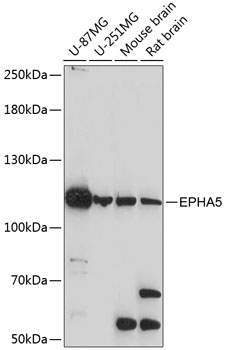Anti-EPHA5 Antibody (CAB14238)
- SKU:
- CAB14238
- Product type:
- Antibody
- Reactivity:
- Human
- Mouse
- Rat
- Host Species:
- Rabbit
- Isotype:
- IgG
- Antibody Type:
- Polyclonal Antibody
- Research Area:
- Neuroscience
Frequently bought together:
Description
| Antibody Name: | Anti-EPHA5 Antibody |
| Antibody SKU: | CAB14238 |
| Antibody Size: | 20uL, 50uL, 100uL |
| Application: | WB IF |
| Reactivity: | Human, Mouse, Rat |
| Host Species: | Rabbit |
| Immunogen: | Recombinant fusion protein containing a sequence corresponding to amino acids 1-130 of human EPHA5 (NP_004430.4). |
| Application: | WB IF |
| Recommended Dilution: | WB 1:500 - 1:2000 IF 1:50 - 1:200 |
| Reactivity: | Human, Mouse, Rat |
| Positive Samples: | U-87MG, U-251MG, Mouse brain, Rat brain |
| Immunogen: | Recombinant fusion protein containing a sequence corresponding to amino acids 1-130 of human EPHA5 (NP_004430.4). |
| Purification Method: | Affinity purification |
| Storage Buffer: | Store at -20°C. Avoid freeze / thaw cycles. Buffer: PBS with 0.02% sodium azide, 50% glycerol, pH7.3. |
| Isotype: | IgG |
| Sequence: | MRGS GPRG AGRR RPPS GGGD TPIT PASL AGCY SAPR RAPL WTCL LLCA ALRT LLAS PSNE VNLL DSRT VMGD LGWI AFPK NGWE EIGE VDEN YAPI HTYQ VCKV MEQN QNNW LLTS WISN EGAS RIFI EL |
| Gene ID: | 2044 |
| Uniprot: | P54756 |
| Cellular Location: | Cell membrane, Cell projection, Single-pass type I membrane protein, axon, dendrite |
| Calculated MW: | 107kDa/112kDa/114kDa |
| Observed MW: | 115kDa |
| Synonyms: | EPHA5, CEK7, EHK-1, EHK1, EK7, HEK7, TYRO4 |
| Background: | This gene belongs to the ephrin receptor subfamily of the protein-tyrosine kinase family. EPH and EPH-related receptors have been implicated in mediating developmental events, particularly in the nervous system. Receptors in the EPH subfamily typically have a single kinase domain and an extracellular region containing a Cys-rich domain and 2 fibronectin type III repeats. The ephrin receptors are divided into 2 groups based on the similarity of their extracellular domain sequences and their affinities for binding ephrin-A and ephrin-B ligands. Alternatively spliced transcript variants encoding different isoforms have been described. |
| UniProt Protein Function: | EphA5: Receptor tyrosine kinase which binds promiscuously GPI- anchored ephrin-A family ligands residing on adjacent cells, leading to contact-dependent bidirectional signaling into neighboring cells. The signaling pathway downstream of the receptor is referred to as forward signaling while the signaling pathway downstream of the ephrin ligand is referred to as reverse signaling. Among GPI-anchored ephrin-A ligands, EFNA5 most probably constitutes the cognate/functional ligand for EPHA5. Functions as an axon guidance molecule during development and may be involved in the development of the retinotectal, entorhino- hippocampal and hippocamposeptal pathways. Together with EFNA5 plays also a role in synaptic plasticity in adult brain through regulation of synaptogenesis. Beside its function in the nervous system, the interaction of EPHA5 with EFNA5 mediates communication between pancreatic islet cells to regulate glucose-stimulated insulin secretion. Belongs to the protein kinase superfamily. Tyr protein kinase family. Ephrin receptor subfamily. 3 isoforms of the human protein are produced by alternative splicing. |
| UniProt Protein Details: | Protein type:Protein kinase, tyrosine (receptor); Kinase, protein; Membrane protein, integral; Protein kinase, TK; EC 2.7.10.1; TK group; Eph family Chromosomal Location of Human Ortholog: 4q13.1 Cellular Component: cell soma; dendrite; external side of plasma membrane; perinuclear region of cytoplasm; plasma membrane; rough endoplasmic reticulum Molecular Function:ephrin receptor activity; GPI-linked ephrin receptor activity Biological Process: activation of CREB transcription factor; axon guidance; cAMP-mediated signaling; ephrin receptor signaling pathway; hippocampus development; neuron development; regulation of actin cytoskeleton organization and biogenesis; regulation of GTPase activity |
| NCBI Summary: | This gene belongs to the ephrin receptor subfamily of the protein-tyrosine kinase family. EPH and EPH-related receptors have been implicated in mediating developmental events, particularly in the nervous system. Receptors in the EPH subfamily typically have a single kinase domain and an extracellular region containing a Cys-rich domain and 2 fibronectin type III repeats. The ephrin receptors are divided into 2 groups based on the similarity of their extracellular domain sequences and their affinities for binding ephrin-A and ephrin-B ligands. Alternatively spliced transcript variants encoding different isoforms have been described. [provided by RefSeq, Aug 2013] |
| UniProt Code: | P54756 |
| NCBI GenInfo Identifier: | 259016353 |
| NCBI Gene ID: | 2044 |
| NCBI Accession: | P54756.3 |
| UniProt Secondary Accession: | P54756,Q7Z3F2, |
| UniProt Related Accession: | P54756 |
| Molecular Weight: | 107,699 Da |
| NCBI Full Name: | Ephrin type-A receptor 5 |
| NCBI Synonym Full Names: | EPH receptor A5 |
| NCBI Official Symbol: | EPHA5 |
| NCBI Official Synonym Symbols: | EK7; CEK7; EHK1; HEK7; EHK-1; TYRO4 |
| NCBI Protein Information: | ephrin type-A receptor 5 |
| UniProt Protein Name: | Ephrin type-A receptor 5 |
| UniProt Synonym Protein Names: | Brain-specific kinase; EPH homology kinase 1; EHK-1; EPH-like kinase 7; EK7; hEK7 |
| Protein Family: | Ephrin type-A receptor |
| UniProt Gene Name: | EPHA5 |
| UniProt Entry Name: | EPHA5_HUMAN |









